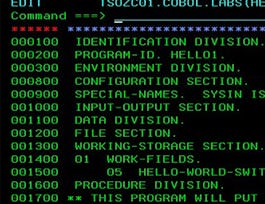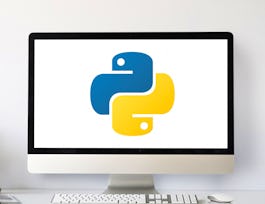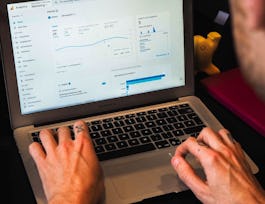This course introduces you to quantum computing, focusing on IBM's Qiskit framework. You'll start with the basics of quantum mechanics, install and test Qiskit 0.23.0, and then explore qubits, learning how they differ from classical bits. Finally, you'll implement quantum gates like the Pauli X, Y, and Z gates.

Offrez à votre carrière le cadeau de Coursera Plus avec $160 de réduction, facturé annuellement. Économisez aujourd’hui.


Practical Quantum Computing with IBM Qiskit for Beginners

Instructeur : Packt - Course Instructors
Inclus avec 
Expérience recommandée
Ce que vous apprendrez
Identify the fundamental concepts of quantum mechanics and quantum computing.
Explain the difference between classical bits and quantum qubits.
Implement quantum gates and circuits using IBM Qiskit.
Compare the behaviors of various quantum gates on different qubit states.
Compétences que vous acquerrez
- Catégorie : Quantum Computing
- Catégorie : IBM Qiskit
- Catégorie : binary digits
- Catégorie : Qiskit
- Catégorie : Computation
- Catégorie : computation
Détails à connaître

Ajouter à votre profil LinkedIn
octobre 2024
16 devoirs
Découvrez comment les employés des entreprises prestigieuses maîtrisent des compétences recherchées


Obtenez un certificat professionnel
Ajoutez cette qualification à votre profil LinkedIn ou à votre CV
Partagez-le sur les réseaux sociaux et dans votre évaluation de performance

Il y a 44 modules dans ce cours
In this module, we will provide a comprehensive overview of the course content and structure. You'll gain insight into what to expect from the course, including the main topics and the learning journey that lies ahead.
Inclus
1 vidéo1 lecture
In this module, we will dive into the foundational concepts of quantum mechanics. You'll explore the core principles that govern quantum behavior, setting the stage for understanding how these principles apply to quantum computing.
Inclus
2 vidéos
In this module, we will examine the key differences between classical bits and quantum qubits. Through a detailed exploration, you'll understand how qubits leverage quantum phenomena like superposition and entanglement to perform complex computations.
Inclus
4 vidéos1 devoir
In this module, we will focus on the practical aspects of working with qubits. You'll learn how to create qubits, maintain their state, and accurately read their information, which is essential for performing reliable quantum computations.
Inclus
2 vidéos
In this module, we will explore how quantum states are represented mathematically using vectors and matrices. You'll gain a deeper understanding of the operations that can be performed on these states and how they relate to quantum computation.
Inclus
1 vidéo
In this module, we will cover the fundamental logic gates that form the basis of classical computing. This overview will prepare you for the transition to quantum logic gates by reinforcing your understanding of basic computational elements.
Inclus
1 vidéo1 devoir
In this module, we will introduce the most widely-used quantum computing frameworks. You'll learn about their unique features and how to choose the right framework for your quantum computing projects.
Inclus
1 vidéo
In this module, we will walk through the process of installing the Anaconda Python distribution, a crucial step in setting up your quantum computing development environment. This will pave the way for working with Qiskit and other essential tools.
Inclus
1 vidéo
In this module, we will cover the installation and initial testing of Qiskit, IBM's open-source quantum computing framework. You'll learn how to set up the framework and verify that it's ready for quantum programming.
Inclus
1 vidéo1 lecture1 devoir
In this module, we will delve into the Pauli X-Gate, a fundamental quantum gate. You'll learn how to implement it in Qiskit and analyze its role in quantum circuits.
Inclus
2 vidéos
In this module, we will focus on customizing the Pauli X-Gate inputs and outputs. You'll explore different scenarios and understand how these customizations influence quantum circuit behavior.
Inclus
1 vidéo
In this module, we will take the Pauli X-Gate from simulation to reality by running it on an actual IBM quantum computer. You'll compare the results and explore the practical challenges of working with real quantum hardware.
Inclus
1 vidéo1 devoir
In this module, we will explore Pauli matrices and their role in representing quantum states as vectors. You'll gain a deeper understanding of their importance in quantum computations.
Inclus
1 vidéo
In this module, we will cover the Pauli Y-Gate, another essential quantum gate. You'll learn how to implement it in Qiskit and examine its effects on quantum circuits.
Inclus
3 vidéos
In this module, we will focus on the Pauli Z-Gate, explaining its operation and significance in quantum circuits. You'll learn how to implement it in Qiskit and analyze its impact on computations.
Inclus
1 vidéo1 devoir
In this module, we will explore eigenvectors associated with the XYZ quantum gates. You'll learn how to find and utilize these eigenvectors in quantum circuits, gaining insights into their role in quantum mechanics.
Inclus
1 vidéo
In this module, we will introduce the Hadamard gate, a key component in quantum computing for creating superpositions. You'll learn its function and how to implement it in Qiskit.
Inclus
1 vidéo
In this module, we will focus on implementing the Hadamard gate in Qiskit with a deeper exploration of its applications in quantum algorithms. You'll analyze the outcomes and understand its role in quantum computations.
Inclus
1 vidéo1 devoir
In this module, we will provide exercises to deepen your understanding of the Hadamard gate. You'll apply it in different scenarios, including combinations with other gates, and analyze the resulting quantum states.
Inclus
3 vidéos
In this module, we will implement the Hadamard gate on a real IBM quantum computer. You'll compare these results with simulations and explore practical challenges encountered in real quantum hardware.
Inclus
1 vidéo
In this module, we will explore the R Phi gate, explaining its function and implementation in quantum circuits using Qiskit. You'll analyze how it affects quantum states and computations.
Inclus
1 vidéo1 devoir
In this module, we will introduce the S and T gates, two important components in quantum circuits. You'll learn how to implement them in Qiskit and understand their role in quantum algorithms.
Inclus
1 vidéo
In this module, we will cover the U and I gates, explaining their applications and implementation in quantum circuits. You'll learn how they are used to control qubit states effectively.
Inclus
1 vidéo
In this module, we will explore the basics of multi-qubit states, highlighting how they differ from single qubit systems. You'll learn about the significance of entanglement and how multi-qubit interactions form the core of quantum computing.
Inclus
1 vidéo1 devoir
In this module, we will focus on representing multi-qubit states using mathematical tools such as tensor products. You'll gain a deeper understanding of how to describe and work with complex quantum systems.
Inclus
1 vidéo
In this module, we will walk through the design of a simple multi-qubit circuit using only single-qubit gates. You'll learn how to construct and analyze this circuit, building your skills in quantum circuit design.
Inclus
1 vidéo
In this module, we will explore a more advanced multi-qubit circuit, again using only single-qubit gates. You'll deepen your understanding of quantum circuits by analyzing the behavior and results of this more complex design.
Inclus
1 vidéo1 devoir
In this module, we will introduce the CNOT gate and explore its role in quantum computing. You'll learn how to implement it with classical qubits and analyze how the control and target qubits interact.
Inclus
1 vidéo
In this module, we will explore the behavior of the CNOT gate when the control qubit is in superposition. You'll learn how this affects the outcome of quantum circuits and gain insights into the power of quantum superposition.
Inclus
1 vidéo
In this module, we will take the CNOT gate with a superposed control qubit and run it on a real IBM quantum computer. You'll compare these results with simulations and explore the practical considerations involved in real-world quantum computing.
Inclus
1 vidéo1 devoir
In this module, we will explore the CNOT gate when both the control and target qubits are in superposition, leading to entangled states. You'll gain insights into the implications of these operations for quantum algorithms.
Inclus
1 vidéo
In this module, we will focus on the behavior of the CNOT gate when the target qubit is in superposition. You'll learn how this affects quantum states and understand the practical applications of this setup in quantum circuits.
Inclus
1 vidéo
In this module, we will introduce and explore common CNOT circuit identities. You'll learn the theory behind these identities and how to implement and verify them using Qiskit, solidifying your understanding of quantum circuit design.
Inclus
2 vidéos1 devoir
In this module, we will delve into the CZ (Controlled-Z) gate and its associated circuit identities. You'll learn how to implement these identities in Qiskit and explore their connection to CNOT circuit identities.
Inclus
2 vidéos
In this module, we will explore the CY (Controlled-Y) gate and its circuit identities. You'll learn how to implement these in Qiskit and understand their impact on quantum states.
Inclus
1 vidéo
In this module, we will cover the SWAP gate, exploring its role and associated circuit identities in quantum circuits. You'll learn how to verify these identities and consider practical applications in quantum computing.
Inclus
1 vidéo1 devoir
In this module, we will introduce the Toffoli gate, also known as the CCNOT gate, and its critical role in quantum computing. You'll learn how to implement it in Qiskit and explore its applications in various quantum algorithms.
Inclus
1 vidéo
In this module, we will delve into Toffoli circuit identities, exploring their theoretical foundations and practical implementation in Qiskit. You'll understand their significance in the design and optimization of quantum circuits.
Inclus
1 vidéo
In this module, we will provide an overview of the Deutsch-Jozsa problem, one of the key problems in quantum computing. You'll learn about its significance and how it demonstrates the power of quantum algorithms over classical ones.
Inclus
1 vidéo1 devoir
In this module, we will focus on designing the Deutsch-Jozsa algorithm, breaking down each step of its construction. You'll learn how this algorithm achieves quantum speedup and analyze its efficiency compared to classical approaches.
Inclus
1 vidéo
In this module, we will implement the Deutsch-Jozsa algorithm in Qiskit, guiding you through the process of testing and verifying its correctness. You'll analyze the results and understand the broader implications of this algorithm for quantum computing.
Inclus
3 vidéos1 devoir
In this module, we will explore quantum key distribution (QKD), a crucial aspect of quantum cryptography. You'll learn how QKD can be implemented to secure communication and understand the impact of quantum computing on traditional cryptographic methods like RSA.
Inclus
2 vidéos
In this module, we will delve into the theory of quantum teleportation, exploring how quantum states can be transmitted instantaneously between distant qubits. You'll learn the steps involved in this process and its potential impact on quantum communication.
Inclus
1 vidéo1 devoir
In this final module, we will offer guidance on further learning opportunities and resources. You'll receive recommendations on how to continue your quantum computing journey and stay abreast of the latest advancements in this rapidly evolving field.
Inclus
1 vidéo1 devoir
Instructeur

Offert par
Recommandé si vous êtes intéressé(e) par Algorithms
Pour quelles raisons les étudiants sur Coursera nous choisissent-ils pour leur carrière ?





Ouvrez de nouvelles portes avec Coursera Plus
Accès illimité à plus de 7 000 cours de renommée internationale, à des projets pratiques et à des programmes de certificats reconnus sur le marché du travail, tous inclus dans votre abonnement
Faites progresser votre carrière avec un diplôme en ligne
Obtenez un diplôme auprès d’universités de renommée mondiale - 100 % en ligne
Rejoignez plus de 3 400 entreprises mondiales qui ont choisi Coursera pour les affaires
Améliorez les compétences de vos employés pour exceller dans l’économie numérique
Foire Aux Questions
Yes, you can preview the first video and view the syllabus before you enroll. You must purchase the course to access content not included in the preview.
If you decide to enroll in the course before the session start date, you will have access to all of the lecture videos and readings for the course. You’ll be able to submit assignments once the session starts.
Once you enroll and your session begins, you will have access to all videos and other resources, including reading items and the course discussion forum. You’ll be able to view and submit practice assessments, and complete required graded assignments to earn a grade and a Course Certificate.





